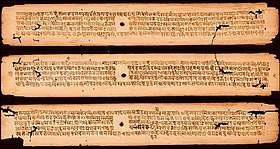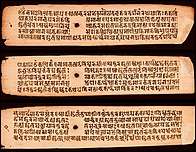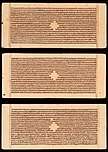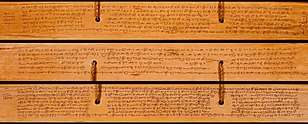Varāhamihira
Varāhamihira (c. early 6th-century), also called Varāha or Mihira, was a Hindu astronomer and polymath who lived in Ujjain (Madhya Pradesh, India). He was born in the Avanti region, roughly corresponding to modern-day Malwa (part of Madhya Pradesh, India), to Adityadasa. According to one of his own works, he was educated at Kapitthaka.[1] The Indian tradition believes him to be one of the "Nine Jewels" (Navaratnas) of the court of ruler Yashodharman Vikramaditya of Malwa.[2][3] However, this claim appears for the first time in a much later text and scholars consider this claim to be doubtful because neither Varahamihira and Vikramaditya lived in the same century nor did Varahamihira live in the same century as some of the other names in the "nine jewels" list such as the much older Kalidasa.[4]
Varāhamihira | |
|---|---|
| Born | c. 500 CE |
| Died | late 6th-century |
| Period | Gupta era |
| Subject | Encyclopedia |
| Notable works | Pancha-Siddhāntikā, Brihat-Samhita, Brihat Jataka |
Varāhamihira's most notable work was Brihat Samhita, an encyclopedic[5] work on architecture, temples, planetary motions, eclipses, timekeeping, astrology, seasons, cloud formation, rainfall, agriculture, mathematics, gemology, perfumes and many other topics.[6][7][8] According to Varahamihira, in some verses he was merely summarizing earlier existing literature on astronomy, Shilpa Sastra and temple architecture, yet his presentation of different theories and models of design are among the earliest texts that have survived.[9][10] The chapters of the Brihat Samhita and verses of Varahamihira were quoted by the Persian traveler and scholar Al Biruni.[11]
Varāhamihira is also credited with writing several authoritative texts on astronomy and astrology. He learned the Greek language, and praised the Greeks (Yavanas) in his text for being "well trained in the sciences". Some scholars consider him to be the strong candidate as the one who understood and introduced the zodiac signs, predictive calculations for auspicious ceremonies and astrological computations to the Indian subcontinent from the Greek literature.[12][13][14]
Works
| Part of a series on |
| Hindu scriptures and texts |
|---|
 |
| Related Hindu texts |
|
Timeline |
Pancha-Siddhantika
Varahamihira's main work is the book Pañcasiddhāntikā ("[Treatise] on the Five [Astronomical] Canons") dated ca. 575 CE, which gives us information about older Indian texts which are now lost. The work is a treatise on mathematical astronomy and it summarises five earlier astronomical treatises by five authors, namely the Surya Siddhanta, Romaka Siddhanta, Paulisa Siddhanta, Vasishtha Siddhanta and Paitamaha Siddhanta. It is a compendium of Vedanga Jyotisha as well as Hellenistic astronomy (including Greek, Egyptian and Roman elements).[lower-alpha 1] Varahamihira was the first one to mention that the ayanamsa, or the shifting of the equinox is 50.32 seconds.
- They [the Indians] have 5 Siddhāntas:
- Sūrya-Siddhānta, the siddhānta of the Sun, thought to be composed by Lāṭadeva, but actually composed by Mayasura also known as Mamuni Mayan as stated in the text itself.
- Vasishtha-siddhānta, so called from one of the stars of the Great Bear, composed by Vishnucandra,
- Paulisa-siddhānta, so called from Paulisa, the Greek, from the city of Saintra, which is supposed to be Alexandria, composed by Paulisa.
- Romaka-siddhānta, so called from the Rūm, ie. the subjects of the Roman Empire, composed by Śrīsheṇa.
- Paitahama-siddhānta.
Brihat-Samhita
Another important contribution of Varahamihira is the encyclopedic Brihat-Samhita. Although the book is mostly about divination, it also includes a wide range of subjects other than divination. It covers wide-ranging subjects of human interest, including astronomy, planetary movements, eclipses, rainfall, clouds, architecture, growth of crops, manufacture of perfume, matrimony, domestic relations, gems, pearls, and rituals. The volume expounds on gemstone evaluation criterion found in the Garuda Purana, and elaborates on the sacred Nine Pearls from the same text. It contains 106 chapters and is known as the "great compilation".
On Astrology

He was also an astrologer.
His son Prithuyasas also contributed to Hindu astrology; his book Hora Sara is a famous book on horoscopy. Khana (also named Lilavati elsewhere), the medieval Bengali poet astrologer, is believed to be the daughter-in-law of Varahamihira.
Influences
The Romaka Siddhanta ("Doctrine of the Romans") and the Paulisa Siddhanta were two works of Western origin which influenced Varahamihira's thought. Paulisa Siddhanta is often mistakenly thought to be a single work and attributed to Paul of Alexandria (c. 378 CE).[16] However, this notion has been rejected by other scholars in the field, notably by David Pingree who stated that "...the identification of Paulus Alexandrinus with the author of the Pauliśa Siddhānta is totally false".[17] Number of his writings share similarities with the earlier texts like Vedanga Jyotisha.[18]
A comment in the Brihat-Samhita, quoting Garga, an earlier astronomer, says: "The Greeks, though barbaric,[19] must be honored since they have shown tremendous interest in our science....." ("mleccha hi yavanah tesu samyak shastram kdamsthitam/ rsivat te 'p i pujyante kim punar daivavid dvijah" (Brihat-Samhita 2.15)).
Contributions
Trigonometry
Varahamihira improved the accuracy of the sine tables of Aryabhata.
Combinatorics
He was among the first mathematicians to discover a version of what is now known as the Pascal's triangle. He used it to calculate the binomial coefficients.[20][21][1] He also records the first known 4×4 magic square.
Optics
Among Varahamihira's contribution to physics is his statement that reflection is caused by the back-scattering of particles and refraction (the change of direction of a light ray as it moves from one medium into another) by the ability of the particles to penetrate inner spaces of the material, much like fluids that move through porous objects.[20]
See also
Notes
- The Pañca-siddhāntikā ("Five Treatises"), a compendium of Greek, Egyptian, Roman and Indian astronomy. Varāhamihira's knowledge of Western astronomy was thorough. In 5 sections, his monumental work progresses through native Indian astronomy and culminates in 2 treatises on Western astronomy, showing calculations based on Greek and Alexandrian reckoning and even giving complete Ptolemaic mathematical charts and tables.[15]
References
- O'Connor, John J.; Robertson, Edmund F., "Varāhamihira", MacTutor History of Mathematics archive, University of St Andrews.
- History of Indian Literature. Motilal Banarsidass Publications. 2008. p. 46.
- Ram Gopal (1984). Kālidāsa: His Art and Culture. Concept Publishing Company. p. 15.
- Moriz Winternitz (1985). History of Indian Literature. Motilal Banarsidass. pp. 45–47. ISBN 978-81-208-0056-4.
- Ariel Glucklich (2008). The Strides of Vishnu: Hindu Culture in Historical Perspective. Oxford University Press. pp. 10, 123–126. ISBN 978-0-19-971825-2., Quote: "[...] the new temples and inconography, the science of architecture, the enormous encyclopedia the Brihat Samhita of Varahamihira [...]"
- Ivor Grattan-Guiness (2016). Companion Encyclopedia of the History and Philosophy of the Mathematical Sciences: Volume Two. Taylor & Francis. pp. 954–956. ISBN 978-1-134-88832-0.
- Varahamihira; M Ramakrishna Bhat (1996). Brhat Samhita of Varahamihira. Motilal Banarsidass. pp. 549–561, 737–738, 874–876. ISBN 978-81-208-1060-0.
- Varahamihira; M Ramakrishna Bhat (1996). Brhat Samhita of Varahamihira, Part 1. Motilal Banarsidass. pp. 1–19. ISBN 978-81-208-1060-0.
- Michael Meister (2003). Gudrun Bühnemann (ed.). Maònòdalas and Yantras in the Hindu Traditions. BRILL Academic. pp. 251–260. ISBN 90-04-12902-2.
- T. A. Gopinatha Rao (1985). Elements of Hindu Iconography. Motilal Banarsidass. pp. 25, 58–59. ISBN 978-81-208-0878-2.
- Varahamihira; M Ramakrishna Bhat (1996). Brhat Samhita of Varahamihira, Part 2. Motilal Banarsidass. pp. 960–961. ISBN 978-81-208-1060-0.
- Moriz Winternitz (1985). History of Indian Literature. Motilal Banarsidass. pp. 685–697. ISBN 978-81-208-0056-4.
- David Pingree (1963), Astronomy and Astrology in India and Iran, Isis, Vol. 54, No. 2, University of Chicago Press, pp. 229-246
- Sarma, K. V. (2008). "Varāhamihira". In Helaine Selin (ed.). Encyclopaedia of the History of Science, Technology, and Medicine in Non-Western Cultures. Dordrecht: Springer Netherlands. pp. 2184–2185. doi:10.1007/978-1-4020-4425-0_9604. ISBN 978-1-4020-4559-2.
- "Varahamihira". Encyclopædia Britannica. 2007.
- McEvilley, Thomas (November 2001). The Shape of Ancient Thought: Comparative Studies in Greek and Indian Philosophies. Allworth Press. p. 385. ISBN 978-1-58115-203-6.
- Pingree, David (1978). The Yavanajātaka of Sphujidhvaja. Harvard Oriental Series. Vol. 2. pp. 437–438.
Pingree, David (1969). The Later Pauliśa Siddhānta. Centaurus 14. pp. 172–241. - Velandai Gopala Aiyer. The chronology of ancient India: beginning of the Sat Yuga, Dwaper, Treta, and Kali Yuga with date of Mahabharata. Sanjay Prakashan. p. 63.
- Monier-Williams. "Definition of म्लेच्छ". Sanskrit Dictionary.
- "Varahamihira". Science, Civilization and Society.
- "History of Mathematics in India". Archaeology Online. 29 April 2014.
External links
- The Brihat-samhita; complete translation by N. Chidambaram Iyer Online edition with glossary
- Pancasiddhantika, Brihat Jataka, Brihat Samhita and Hora Shastra Various editions in English and Sanskrit. (PDF)
- The Brihat Jataka (1905) Pdf edition internet archive


